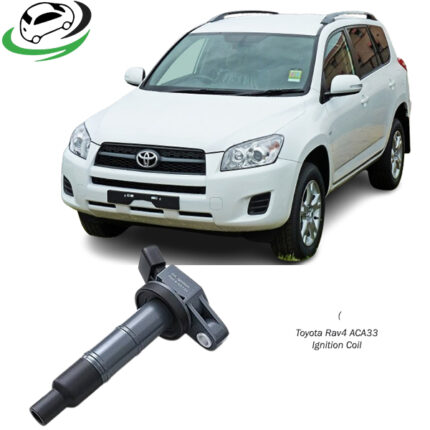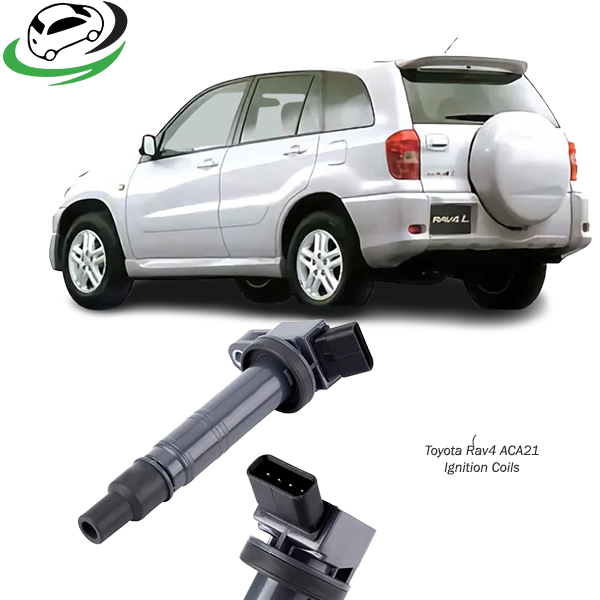-22%
Get Toyota Rav4 ACA21 Ignition Coils 90919-02248
An ignition coil, also known as a spark coil, is an induction coil in an automobile’s ignition system that converts the battery’s 12 volts to the high voltage required to create an electric spark in the spark plugs to ignite the fuel.
Functionality
The ignition coil works on the principle of electromagnetic induction. It consists of two coils of wire, the primary coil and the secondary coil, wound around a laminated iron core. When current flows through the primary coil, it creates a magnetic field. When this current is interrupted, the magnetic field collapses, inducing a high voltage in the secondary coil. This high voltage is then directed to the spark plugs to ignite the air-fuel mixture in the engine’s cylinders.
Components of an Ignition Coil
Primary Coil
The primary coil consists of a few hundred turns of heavy-gauge wire. When current from the battery flows through this coil, it generates a strong magnetic field around the iron core.
Secondary Coil
The secondary coil is made up of thousands of turns of fine-gauge wire. It is wound on top of the primary coil. The sudden collapse of the magnetic field in the primary coil induces a high voltage in the secondary coil.
Iron Core
The iron core is located at the center of the coil and enhances the magnetic field generated by the primary coil, making the voltage induction in the secondary coil more efficient.
Housing
The housing encases the coils and the iron core, providing protection from physical damage, moisture, and other environmental factors. It is typically made of plastic or resin.
Terminals
Ignition coils have terminals for electrical connections. The primary terminals connect to the battery and ignition switch, while the secondary terminal connects to the distributor or directly to the spark plug in some modern systems.
Types of Ignition Coils
Conventional Ignition Coil
The conventional ignition coil is used in older vehicles with distributor-based ignition systems. It works with a mechanical distributor and rotor to distribute the high voltage to the correct spark plug.
Distributorless Ignition System (DIS) Coil
DIS coils are used in modern vehicles that do not have a distributor. Instead, they have multiple coils, each serving one or two cylinders. These coils are controlled by the engine control unit (ECU), which precisely times the spark for each cylinder.
Coil-on-Plug (COP) Ignition Coil
COP ignition coils are the most advanced type, found in many modern engines. Each spark plug has its own coil mounted directly on top of it, eliminating the need for spark plug wires. This design reduces energy loss and improves ignition efficiency.
Working Mechanism
Charging Phase
When the ignition switch is turned on, current flows from the battery to the primary coil through the ignition control module. This creates a magnetic field around the iron core.
Triggering Phase
The ignition control module interrupts the current flow in the primary coil at the precise moment the spark is needed. This interruption causes the magnetic field to collapse rapidly.
Discharge Phase
The collapsing magnetic field induces a high voltage in the secondary coil. This high voltage is then sent to the spark plug via the secondary terminal, creating a spark that ignites the air-fuel mixture.
Benefits of Ignition Coils
Improved Engine Performance
High-quality ignition coils ensure a strong and consistent spark, leading to better combustion of the air-fuel mixture. This results in improved engine performance, smoother acceleration, and increased power output.
Fuel Efficiency
Efficient ignition coils contribute to complete combustion of the fuel, which reduces fuel consumption and increases fuel efficiency. This is especially important in modern engines designed to meet stringent emission standards.
Reduced Emissions
A strong and reliable spark ensures that the air-fuel mixture burns completely, reducing the amount of unburned hydrocarbons and other pollutants emitted from the exhaust.
Durability and Reliability
Modern ignition coils are designed to be durable and reliable, capable of withstanding extreme temperatures and operating conditions. This longevity reduces the need for frequent replacements and maintenance.
Maintenance and Troubleshooting
Regular Inspection
Regular inspection of ignition coils is crucial to ensure they are functioning correctly. Look for signs of physical damage, such as cracks in the housing or corrosion on the terminals.
Testing
Use a multimeter to test the resistance of the primary and secondary coils. Compare the readings to the manufacturer’s specifications. A significant deviation may indicate a faulty coil.
Symptoms of a Faulty Ignition Coil
1. Engine Misfires
Definition
Engine misfires occur when the air-fuel mixture in one or more cylinders fails to ignite properly. This results in incomplete combustion, causing the engine to run rough and unevenly.
Symptoms
- Rough Idle: The engine may idle unevenly, with noticeable vibrations or shaking.
- Hesitation or Jerking: During acceleration, the engine may hesitate or jerk, especially under load.
- Loss of Power: Misfires can lead to a significant loss of engine power and reduced performance.
- Increased Emissions: Unburned fuel can lead to increased emissions, potentially causing the vehicle to fail emission tests.
Cause
A faulty ignition coil can produce a weak or inconsistent spark, resulting in inadequate ignition of the air-fuel mixture in the affected cylinder(s). This leads to misfires and the associated symptoms.
2. Difficulty Starting the Engine
Definition
Starting difficulties refer to issues encountered when attempting to start the engine. The engine may crank but fail to start promptly or require multiple attempts to start.
Symptoms
- Extended Cranking: The engine may crank for an extended period before starting.
- Intermittent Starting: The engine may start inconsistently, requiring repeated attempts.
- Hard Starting: Starting the engine may feel unusually difficult or sluggish.
Cause
A faulty ignition coil can result in weak or intermittent sparks, especially when the engine is cold or under initial startup conditions. This can make it challenging to ignite the air-fuel mixture effectively, leading to difficulty starting the engine.
3. Engine Stalling
Definition
Engine stalling refers to the abrupt and unexpected shutdown of the engine during operation. This can occur at idle or while driving and poses a safety risk, especially in traffic or hazardous conditions.
Symptoms
- Abrupt Shutdown: The engine may suddenly shut off without warning.
- Loss of Power Steering and Brakes: When the engine stalls, power steering and brake assistance may be lost, making it challenging to maneuver or stop the vehicle safely.
- Dashboard Warning Lights: The check engine light or other warning lights may illuminate on the dashboard.
Cause
A faulty ignition coil can lead to intermittent sparks or complete failure to produce sparks. This inconsistency can cause the engine to stall abruptly, as the affected cylinder(s) fail to ignite the air-fuel mixture, resulting in engine shutdown.
4. Decreased Fuel Efficiency
Definition
Fuel efficiency refers to the distance traveled per unit of fuel consumed. A decrease in fuel efficiency indicates that the engine is burning more fuel than necessary to produce the same amount of power.
Symptoms
- Increased Fuel Consumption: The vehicle may consume more fuel than usual for the same driving conditions and distance.
- Reduced Mileage: The distance traveled per gallon or liter of fuel may decrease noticeably.
- Poor Fuel Economy: The vehicle’s fuel efficiency rating may drop below its typical range.
Cause
A faulty ignition coil can lead to inefficient combustion of the air-fuel mixture. Incomplete combustion results in wasted fuel, as unburned fuel is expelled through the exhaust without generating power. This reduces fuel efficiency and increases fuel consumption.
5. Illumination of Check Engine Light
Definition
The check engine light (CEL) is part of the vehicle’s onboard diagnostics system. It illuminates when the engine control unit (ECU) detects a problem that affects engine performance, emissions, or safety.
Symptoms
- Check Engine Light (CEL) Illumination: The CEL may illuminate and remain steady or blink to indicate a serious issue.
- Diagnostic Trouble Codes (DTCs): The ECU stores specific codes related to the ignition system, which can be retrieved using a diagnostic scanner.
Cause
A faulty ignition coil can trigger the check engine light by causing misfires, abnormal combustion, or other issues detected by the ECU. Diagnostic trouble codes (DTCs) related to ignition coil faults (e.g., P0300 to P0308 for misfires) can provide specific information about the problem.
6. Rough Engine Performance
Definition
Rough engine performance refers to irregular operation characterized by vibrations, noise, or uneven power delivery. It often accompanies misfires and other ignition-related issues.
Symptoms
- Vibration: The engine may vibrate excessively, especially at idle or low speeds.
- Noise: Unusual noises, such as popping or backfiring, may occur during operation.
- Uneven Power Delivery: The engine may exhibit inconsistent power output, affecting acceleration and smoothness.
Cause
A faulty ignition coil can lead to uneven sparks or misfires, resulting in rough engine performance. The uneven combustion of the air-fuel mixture causes vibrations, noise, and irregular power delivery, affecting overall engine operation.
7. Electrical Issues
Definition
Electrical issues refer to problems with the vehicle’s electrical system, particularly related to ignition system components like ignition coils.
Symptoms
- Flickering Lights: Lights, such as headlights or dashboard lights, may flicker or dim unexpectedly.
- Electrical Noise: Interference or static noise may be heard through the vehicle’s audio system.
- Battery Drain: A faulty ignition coil can draw excessive current, leading to battery drain and potential starting issues.
Cause
A faulty ignition coil can cause electrical disturbances due to irregular current flow or voltage spikes. These disturbances can affect other electrical components, causing flickering lights, noise interference, or excessive battery drain.
Replacement
If an ignition coil is found to be faulty, it should be replaced promptly to avoid further damage to the engine and other components. Ensure that the replacement coil is compatible with the vehicle’s make and model.
Follow us on Facebook for more parts.



